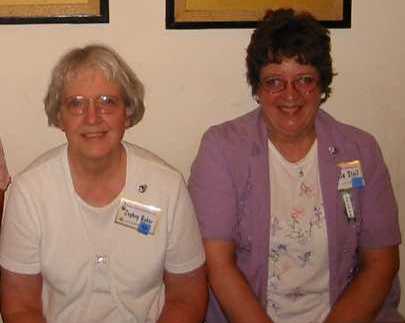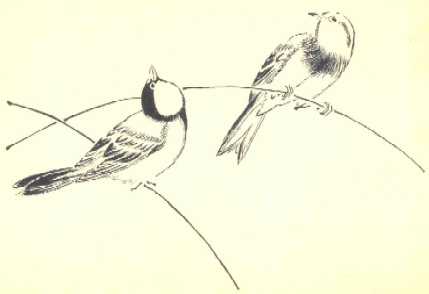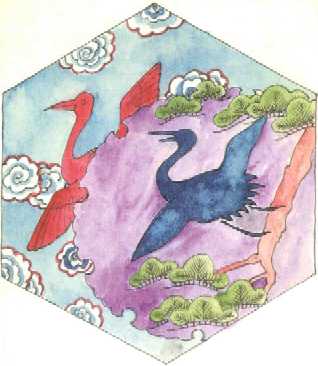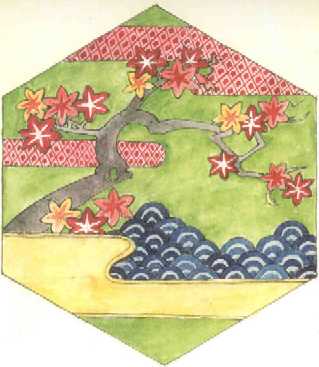|
|
|

|

|
Zephyr Baker (left) and
Luella Steil (right)
|
|
|
The sixty students of Mochi Elementary School in Nara Prefecture have two
special American friends, Luella Steil and Zephyr Baker. These two sisters,
one living in Georgia and the other in Ohio, regularly exchange cards, small
gifts, videos, and e-mail with the students, teachers, and principal of Mochi
Elementary School. The school holds an annual "Mary Day"
celebration in honor of the doll received in 1927 from Luella and Zephyr's
mother, Mary Louise Williamson Steil. Zephyr describes the relationship with
Mochi Elementary, "This is a wonderful cultural exchange and an ongoing
friendship all because a six-year-old girl told her father, 'I want to send a
doll to Japan.'"
In 1926, the father of Mary Louise Williamson served as the superintendent
of the Market Street Baptist Church Sunday School in Zanesville, Ohio. When
he came home one Sunday with news of a nationwide project to send American
dolls to children in Japan, his young daughter Mary Louise really wanted to
send a doll to faraway Japan. She sent a small doll with dark hair and a
light dress. She named the doll "Mary Louise" after herself, and
her father included the church's address with the doll.
|
|
|

|
|
One of drawings from 1927 in
Mary Louise's box
|

|
|
|
The Box
In 1963, many years after the doll had been sent to Japan, Mary Louise and
her brothers discovered a small wooden box when sorting through things to
close the house after their mother's death. The box contained lovely art
work, papers written in Japanese, and a couple of photos of an American doll
surrounded by many Japanese children holding their dolls. The wooden box had
"Naraken" (Nara Prefecture) written on one end, and one of the
papers inside the box had her unmarried name, "Mary Louise
Williamson." Mary Louise took this box with precious memories from long
ago to her home and carefully stored it.
Many years later, in 1985, when Market Street Baptist Church celebrated
its 150th anniversary, Mary Louise again took out the box addressed to the
Sunday School. When asked by the church pastor to share stories of old times,
Mary Louise showed the contents of the box and "told the story of
friendship and sharing a doll with the Japanese children." Later that
year, she went to Ohio State University and received help from a Japanese
student to translate some of the letters. She found out then that the papers
were letters from children thanking the giver of the doll who could say
"mama" and could open and close her eyes.
In the early 1990s, Mary Louise got involved with a local doll club so she
could find out more about the 8 to 10 dolls she had kept from her childhood.
One day in the spring of 1997, the president of her local doll club called to
tell her of an advertisement about the 70th-anniversary celebration of the
Friendship Doll Exchange sponsored by the Japanese Asian Doll Enthusiasts
(JADE). This was the first time she even heard of the 58 Japanese Ambassador
Dolls sent by Japan to the U.S. in 1927 as a thank-you gift for the nearly
13,000 American dolls that arrived in Japan in early 1927. In July 1997, Mary
Louise, her husband, and her two oldest daughters (Zephyr and Luella) attended the JADE
convention in Anaheim, California, to tell the story of the doll sent 70
years before and of the special wooden box with its precious contents. Mary
Louise said, "It takes the common man, not government, to make
peace."
|
|
|
|
|

|

|
One of drawings from 1927 in
Mary Louise's box
|
|
|
NHK Program
In 1997, Japan's largest television broadcasting company (NHK)
decided to film a special documentary about Mary Louise and a Japanese
woman who participated in the 1927 Friendship Doll Exchange. In
September 1997, a woman from NHK talked with Mary Louise at the airport in
Columbus, Ohio, and filmed the special wooden box and its contents. The next
month NHK flew Mary Louise and her husband, accompanied by their two
daughters Luella and Zephyr, to visit Mochi Elementary School, the school in
Nara Prefecture that received Mary Louise's American doll as a friendship
messenger in 1927. Although the doll at Mochi Elementary did not survive
World War II, Mary Louise had the opportunity to meet five of the school's
alumni who had sent the thank-you letters and the art work so long ago.
Luella describes the scene, "They couldn't understand each other's
language but they were really communicating" (of course with an
interpreter).
Mary Louise and her family participated in a school assembly, where the
children sang songs such as "A Small World" to greet the special
visitors from America. Mary Louise presented to the school a new brown-eyed
doll named Mary to replace the original doll sent in 1927. The students of
Mochi Elementary presented Mary Louise with a small Japanese Ichimatsu doll
in return. After the visit to Mochi Elementary, the group had an opportunity
to visit another elementary school in Nara Prefecture to see one of the
original American dolls sent in 1927.
|
|
|

|
|
One of drawings from 1927 in
Mary Louise's box
|

|
|
|
Continuing Friendships
Since 1997, Luella and Zephyr have continued to correspond with Mr.
Shiroi, the principal of Mochi Elementary School. Also, the two sisters have
continued to send various gifts to each of the 60 students at the school.
These gifts have included Japanese-American friendship pins, Valentine's Day
cards, matchbox cars (for boys), miniature dolls inside matchboxes (for
girls), and "Jingle Bell" necklaces. Although the students are
lucky to have such two good friends from America, Luella says, "I feel I
am the lucky one."
In November 2001, Luella and Zephyr visited Mochi Elementary School
for the second time in order to attend the 4th annual "Mary Day"
celebration in honor of their mother's visit in 1997 and the two dolls she
has given to the school. Zephyr says she was in "sheer awe" during
the visit, and Luella exclaims, "of all the places I have been, that
trip topped them all." About 200 people, including alumni and other
residents of the town, attended the "Mary Day" ceremony. Luella
entertained the audience by doing a clog dance with a traditional dress, and
Zephyr sang "Let There Be Peace on Earth."
Luella and Zephyr hope to continue for many years the family tradition of
friendship with Mochi Elementary School started in 1927 by their mother Mary
Louise.
|
|
|



